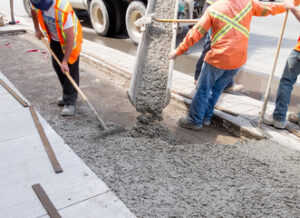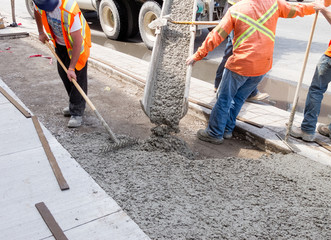Concrete Contractors help with the construction of structures or buildings. Concrete Contractors Dallas TX are familiar with industry standards and safety regulations. When choosing a concrete contractor, look for one who is friendly and responds promptly to your questions. They also should be able to provide the right ready-mix concrete needed for your project.
 Formwork is a framework that holds wet concrete until it sets, creating the shape of a structure. It can be permanent or temporary, and concrete contractors need to design a formwork system that balances quality, cost and safety. Formwork can be a major source of stress on construction sites and may need to be reinforced and braced to prevent collapse or damage to the concrete.
Formwork is a framework that holds wet concrete until it sets, creating the shape of a structure. It can be permanent or temporary, and concrete contractors need to design a formwork system that balances quality, cost and safety. Formwork can be a major source of stress on construction sites and may need to be reinforced and braced to prevent collapse or damage to the concrete.
The formwork itself can be made from a variety of materials, including wood, plywood, aluminum or steel. Contractors must consider the type of concrete being poured as well as the pouring temperature, since these factors affect the pressure exerted on the formwork by the concrete. It’s also important that the formwork is designed to avoid movement during construction procedures, and it’s common for a contractor to utilize structures called falsework to support and stabilize the main formwork.
Depending on the type of concrete being poured, formwork systems can be either temporary or permanent. Temporary formwork is a popular choice for construction projects, as it’s quick and easy to install, remove and reuse multiple times. This can help save on construction costs, especially when a concrete contractor has many projects in progress at once.
Once the concrete contractor and architect-engineer have looked at the structural and architectural drawings of a project, they’ll select a formwork system that will suit their needs. It’s typically shipped in component pieces or already assembled, and it’s important that the formwork be treated with a release agent to prevent the concrete from sticking to the form.
Concrete is heavy, and formwork must be constructed to be able to support its weight, as well as the loads exerted by construction equipment like concrete trucks and pumps. It’s also important that the formwork doesn’t create any bulges in the finished concrete, which could weaken its overall strength.
A formwork system that’s poorly designed or built can be disastrous, resulting in dangerous accidents. Some of these incidents have even led to death on the construction site. For example, in Bailey’s Crossroads, Virginia in 1972, workers removed the shores — supports that hold up horizontal slabs while concrete sets — from the 24th floor of a building too early, causing it to collapse, killing 14 workers [source: Hurd]. In many cases, formwork collapsing is caused by overloading the form with concrete, improper bracing, inadequate shoring and insufficient strength in the concrete before removal of the forms [source: Stamaty]. However, the majority of formwork failures are due to poor erection techniques.
Concrete Placement
Concrete placement is one of the most important steps in the concreting process. It comes after transportation and before compaction. It also determines how strong the concrete structure will be. It requires specialized equipment and knowledge. Placing concrete correctly can help to prevent segregation, bleeding and weak spots. Concrete contractors must work quickly to ensure that different concrete layers mix together properly. Otherwise, the result will be cold joints, which are weak points in the concrete that occur when different concrete layers don’t intermix.
The proper placement of concrete depends on many factors, including the temperature and the environment. For example, concrete placed in hot temperatures can dry too quickly and create weak spots. It’s also important to monitor the ambient air temperature and humidity to avoid any problems with freezing and thawing.
To avoid these problems, a concrete contractor must plan the job before starting the actual placement. They must make sure that the site is free of rocks, vegetation and other organic matter. They must also prepare the ground for the concrete by removing loose soil, sand and gravel. Then they must compact the ground to achieve a stiff bed. They must also ensure that the water and slush are diverted away from the concreting area.
Concrete placement can be done either by hand or with a mechanical system. In general, it’s better to use a mechanical system because it can place the concrete more accurately and faster. It can also reduce the risk of errors and improve the quality of the finished product.
The equipment used for concrete placement should be designed to be mortar tight and to deliver a nearly continuous flow of concrete to the delivery point without separation of materials. It should be capable of transporting, placing and compacting concrete at rates of up to 200 cubic yards per hour. For large projects, concrete contractors may need to install multiconveyor systems, which are a combination of conveyors that allow them to produce and place concrete more efficiently. These systems are also safer and more cost effective than using tower cranes.
Finishing
Concrete is an extremely versatile construction material that can be used in a variety of applications. It is also known for its durability and strength. In addition, it can be molded into many shapes to create unique building features. This versatility is one of the main reasons why it is such a popular choice for residential and commercial use.
Formwork is a common practice in concrete construction and is done by professional concrete contractors. It helps to ensure that the concrete is placed correctly and stays in place while it hardens. Formwork can be made out of wood, plastic, steel, or another material. The size of formwork depends on the project and its needs.
Once the concrete has been mixed, it must be transported to the area where it is needed to be poured and placed. It is often transported by truck, poured free of gravity using a tremie, or pumped through a pipe for larger projects. Smaller amounts are carried in a skip, wheelbarrow, or trough.
Before pouring, the contractor must prepare the site by excavating and backfilling. This will ensure that the ground is ready to support the concrete for its long life. It will also prevent moisture and ground contamination that could damage the concrete.
After the concrete is poured, the concrete finisher smooths the surface with a trowel. The smoother the concrete, the better it will hold up over time. The finishing process is also a great time to add color to the concrete. This can be accomplished through mix-added pigments or post-cure staining.
Control joints must be cut into the concrete at regular intervals to eliminate unsightly cracking as it cures. The space between control joints should be at least twice the width of the slab. It is important to remember that these cuts must be made before the concrete has reached its full strength.
It is vital for concrete contractors to work with reliable suppliers. These companies provide them with the concrete they need to complete their projects. They also help with scheduling, ordering supplies, and providing technical support. They may even offer additional services, such as precasting and estimating.
Safety
Concrete contractors are not only concerned about the quality of the finished product but also with the safety of everyone working on the construction site. They need to follow all Occupational Safety and Health Administration (OSHA) guidelines to keep their crew members safe.
Among the most critical safety precautions is wearing appropriate protective gear like gloves, eye protection and a hard hat. Workers should also take frequent breaks and have access to drinking water.
Another essential safety precaution is to ensure that all equipment is in good condition. Concrete is a heavy material and any equipment that is not in tip-top shape can fail at any time. For example, formwork and shoring equipment need to be solid without any weak spots or cracks that could collapse with hundreds of pounds of concrete on them.
Contractors should check the condition of their equipment regularly and maintain it properly. This can prevent accidents and injuries that could harm the crew. Additionally, it is important to make sure that any hazards are clearly marked and easily visible to all crew members. This can be done by using a concrete subcontractor software that allows for quick communication to alert all workers of potential dangers.
Concrete work can be quite noisy, which is why all workers should wear ear protection. Whether they are cutting, pouring or performing any other concrete related activities, loud noises can cause permanent hearing damage. If you notice any problems with your ears, it is a good idea to visit a doctor immediately.
If your eyes come into contact with concrete dust, it can cause chemical burns. The best way to avoid this is by wearing boots and gloves that are resistant to the alkali chemicals in concrete. If your skin does become irritated, you should rinse it with water right away.
While there are many concrete construction hazards, they don’t have to be life-threatening. With proper training and careful handling, you can safely complete construction projects on time and within budget. It is vital to review the reports from each project and analyze any areas that need improvement. This will help reduce the number of hazards and injuries on the job site, saving you money in lost production, worker’s compensation costs and morale issues.
